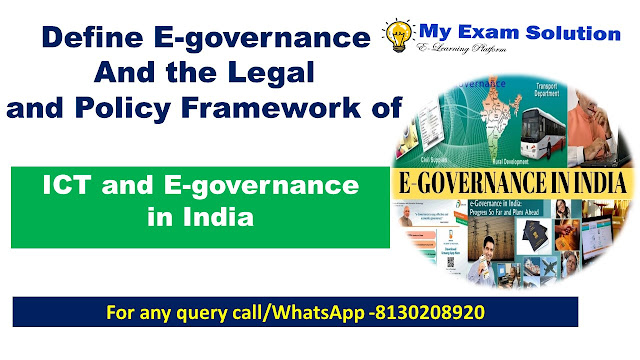Define e-governance and the legal and policy framework of ICT and e-governance in India
What is e-Administration?
Electronic administration or e-administration is taken on by
nations across the world. In a quickly developing and requesting economy like
India, e-administration has become fundamental. The quick development of
digitalisation has prompted numerous state run administrations across the globe
to bring and integrate innovation into legislative cycles. Electronic
administration or e-administration can be characterized as the utilization of
Data and Correspondence Innovation (ICT) by the public authority to give and
work with taxpayer supported organizations, trade of data, correspondence
exchanges and joining of different independent frameworks and administrations.
Define e-governance and the legal
and policy framework of ICT and e-governance in India
As such, it is the utilization of innovation to perform
government exercises and accomplish the targets of administration. Through
e-administration, taxpayer supported organizations are made accessible to
residents and organizations in a helpful, proficient and straightforward way.
Instances of e-administration incorporate Advanced India drive, Public Gateway
of India, Head of the state of India entryway, Aadhaar, recording and
installment of charges on the web, computerized land the board frameworks,
Normal Entry Test and so on.
Sorts of communications in e-Administration
e-Administration can happen in four significant sorts of
cooperations, aside from the cycles and collaborations in the administrative
center, inside the public authority structure:
Government to Government (G2G)
Data is traded inside the public authority i.e., either,
between the focal government, state government and nearby legislatures or
between various parts of a similar government.
Define e-governance and the legal
and policy framework of ICT and e-governance in India
Government to Resident (G2C)
The residents have a stage through which they can connect
with the public authority and gain admittance to the range of public
administrations presented by the Public authority.
Government to Organizations (G2B)
The organizations can cooperate with the public authority
flawlessly regarding the administrations of the public authority proposed to organizations
Government to Workers (G2E)
The communication between the public authority and its
workers happens in an effective and fast way.
Goals of e-Administration
- The goals of e-administration can be recorded down as given underneath:
- To help and improve on administration for government, residents, and organizations.
- To make government organization more straightforward and responsible while tending to the general public's requirements and assumptions through proficient public administrations and viable collaboration between individuals, organizations, and government.
- To diminish defilement in the public authority.
- To guarantee rapid organization of administrations and data.
- To lessen troubles for business, give quick data and empower advanced correspondence by e-business.
Define e-governance and the legal
and policy framework of ICT and e-governance in India
While e-administration gives the benefits of comfort,
proficiency and straightforwardness, it additionally has issues related with
it. They are as per the following:
Absence of PC proficiency: India is as yet a non-industrial
nation and a greater part of the residents need PC education which impedes the
viability of e-administration.
Absence of openness to the web or even PCs in certain pieces
of the nation is a weakness to e-administration.
e-Administration brings about a deficiency of human
communication. As the framework turns out to be more automated, lesser
communication happens among individuals.
It brings about the gamble of individual information robbery
and spillage.
e-Administration prompts a remiss organization. The
specialist co-op can without much of a stretch give reasons to not offering the
support on specialized grounds, for example, "server is down" or
"web isn't working", and so on.
e-Administration in the Indian setting
e-Administration in India is an as of late evolved idea. The
send off of Public Satellite-Based PC Organization (NICENET) in 1987 and
resulting send off of the Area Data Arrangement of the Public Informatics Place
(DISNIC) program to automate all locale workplaces in the country for which
free equipment and programming was proposed to the State Legislatures gave the
imperative catalyst to e-administration.
Define e-governance and the legal
and policy framework of ICT and e-governance in India
e-Administration from that point created with the development
of innovation. Today, there are countless e-Administration drives, both at the
Association and State levels. In 2006, the Public e-Administration Plan (NeGP)
was figured out by the Branch of Hardware and Data Innovation and Division of
Regulatory Changes and Public Complaints that targets making all taxpayer
driven organizations open to the average person, guarantee proficiency,
straightforwardness and unwavering quality of such administrations at
reasonable expenses to understand the fundamental requirements of the everyday
person.
ALSO READ:-
Sustainable Development And Enumerate Its Major Challenges To Sustainable Development And Environment







0 comments:
Note: Only a member of this blog may post a comment.